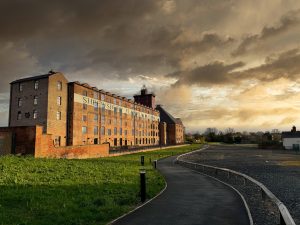
The Shrewsbury Flaxmill, also known as the Ditherington Flax Mill, is a remarkable piece of industrial heritage located in Shrewsbury, Shropshire. It holds the distinction of being the world’s first iron-framed building, earning it the moniker “the grandfather of skyscrapers.” This pioneering structure, which opened its doors in 1797, marked a significant turning point in architectural design, paving the way for the development of modern skyscrapers.
The Flaxmill was the brainchild of Charles Bage, an architect whose design was inspired by the fireproof mills of William Strutt. Bage’s innovative use of iron framing overcame the prevalent issue of fire hazards in mills, which were traditionally constructed with timber frames. The iron frame also allowed for significantly larger windows, which were able to let in more light and thereby improved working conditions for the mill workers.
The mill was initially established to spin linen thread from flax, a thriving business that led to the expansion of the site. John Marshall, one of the original partners, eventually bought out the others and became the sole owner in 1804. At its peak, the Flaxmill was a bustling hub of activity, employing over 800 men, women, and children. It even played a role during the Napoleonic Wars, producing uniforms for British soldiers.
However, the flax industry began to decline, and the mill ceased operations in 1886. It was then sold and repurposed into a maltings facility, processing barley for the brewing industry. This adaptation led to many of the building’s windows being bricked up to maintain the dark conditions suitable for malting barley.
The maltings operated until 1987, after which the complex fell into disrepair. Recognizing the historical significance of the Flaxmill, Historic England purchased the site in 2005. A partnership with Shropshire Council and the Friends of the Flaxmill Maltings was formed to preserve the buildings and find a sustainable future for them.
After years of dereliction, the Flaxmill has undergone extensive restoration. It has been transformed into a mixed-use workspace and exhibition space, officially opening to the public in 2022. The restoration efforts have been meticulous, ensuring that the historical integrity of the buildings is maintained while adapting them for modern use.
Today, the Shrewsbury Flaxmill Maltings stands as a testament to the industrial revolution and the innovative spirit of the era. It serves as a reminder of the ingenuity that laid the foundations for the architectural marvels we see in our skylines today. The site is not only a place of work but also a cultural and educational resource, offering insights into the past and inspiration for the future.
The Shrewsbury Flaxmill complex, a site of great historical significance, comprises several key buildings. Here’s a list of the main structures within the complex:
- Main Mill: The centerpiece of the complex, the Main Mill is the world’s first iron-framed building and is recognized as a Grade I listed building.
- Cross Mill: Built shortly after the Main Mill, it was used for preparing and spinning flax.
- Apprentice House: This building housed the apprentices who worked in the mills.
- Stables: These provided accommodation for the horses that originally powered the mill machinery.
- Smithy: A place where metalwork was carried out by blacksmiths to support the mill’s operations.
- Warehouse: Used for storing both raw materials and finished products.
- Engine House: Contained the steam engines that powered the mill’s machinery.
- Kiln: Used during the building’s time as a maltings to dry the malted barley.
These buildings reflect the evolution of the site from a flax mill to a maltings and now to a mixed-use space following extensive restoration efforts
The Flaxmill’s story is one of innovation, evolution, and resilience. From its origins as a groundbreaking flax mill to its current role as a revitalized community asset, the site continues to evolve. It is a symbol of Shrewsbury’s rich industrial past and a beacon of preservation and adaptive reuse. The Shrewsbury Flaxmill Maltings remains an enduring legacy of the industrial age and a shining example of how historical buildings can be given a new lease on life in the 21st century
Prints available through lupaimages.photos